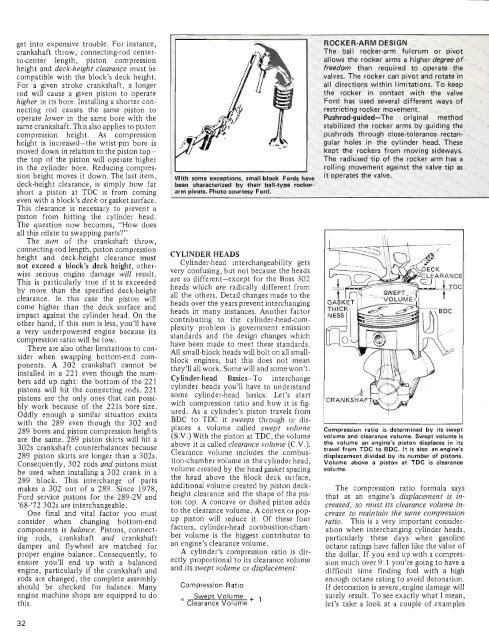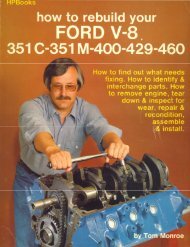How To Rebuild Your Small-Block Ford.pdf - Index of
How To Rebuild Your Small-Block Ford.pdf - Index of
How To Rebuild Your Small-Block Ford.pdf - Index of
Create successful ePaper yourself
Turn your PDF publications into a flip-book with our unique Google optimized e-Paper software.
get into expensive trouble. For instance,<br />
crankshaft throw, connecting-rod centerto-center<br />
length, piston compression<br />
height and deck-height clearance must be<br />
compatible with the block's deck height.<br />
For a given stroke crankshaft, a longer<br />
rod will cause a given piston to operate<br />
higher in its bore. Installing a shorter connecting<br />
rod causes the same piston to<br />
operate lower in the same bore with the<br />
same crankshaft. This also applies to piston<br />
compression height. As compression<br />
height is increased-the wrist-pin bore is<br />
moved down in relation to the piston topthe<br />
top <strong>of</strong> the piston will operate higher<br />
in the cylinder bore. Reducing compression<br />
height moves it down. The last item,<br />
deck-height clearance, is simply how far<br />
short a piston at TDC is from coming<br />
even with a block's deck or gasket surface.<br />
This clearance is necessary to prevent a<br />
piston from hitting the cylinder head.<br />
The question now becomes, "<strong>How</strong> does<br />
all this relate to swapping parts"<br />
The sum <strong>of</strong> the crankshaft throw,<br />
connecting-rod length, piston compression<br />
height and deck-height clearance must<br />
not exceed a block's deck height, otherwise<br />
serious engine damage will result.<br />
This is particularly true if it is exceeded<br />
by more than the specified deck-height<br />
clearance. In this case the piston will<br />
come higher than the deck surface and<br />
impact against the cylinder head. On the<br />
other hand, if this sum is less, you'll have<br />
a very underpowered engine because its<br />
compression ratio will be low.<br />
There are also other limitations to consider<br />
when swapping bottom-end components.<br />
A 302 crankshaft cannot be<br />
installed in a 221 even though the numbers<br />
add up right: the bottom <strong>of</strong> the 221<br />
pistons will hit the connecting rods. 221<br />
pistons are the only ones that can possibly<br />
work because <strong>of</strong> the 221s bore size.<br />
Oddly enough a similar situation exists<br />
with the 289 even though the 302 and<br />
289 bores and piston compression heights<br />
are the same. 289 piston skirts will hit a<br />
302s crankshaft counterbalances because<br />
289 piston skirts are longer than a 302s.<br />
Consequently, 302 rods and pistons must<br />
be used when installing a 302 crank in a<br />
289 block. This interchange <strong>of</strong> parts<br />
makes a 302 out <strong>of</strong> a 289. Since 1978,<br />
<strong>Ford</strong> service pistons for the 289-2V and<br />
'68-'72 302s are interchangeable.<br />
One final and vital factor you must<br />
consider when changing bottom-end<br />
components is balance. Pistons, connecting<br />
rods, crankshaft and crankshaft<br />
damper and flywheel are matched for<br />
proper engine balance. Consequently, to<br />
ensure you'll end up with a balanced<br />
engine, particularly if the crankshaft and<br />
rods are changed, the complete assembly<br />
should be checked for balance. Many<br />
engine machine shops are equipped to do<br />
this.<br />
CYLINDER HEADS<br />
Cylinder-head interchangeability gets<br />
very confusing, but not because the heads<br />
are so different-except for the Boss 302<br />
heads which are radically different from<br />
all the others. Detail changes made to the<br />
heads over the years prevent interchanging<br />
heads in many instances. Another factor<br />
contributing to the cylinder-head-complexity<br />
problem is government emission<br />
standards and the design changes which<br />
have been made to meet these standards.<br />
All small-block heads will bolt on all smallblock<br />
engines, but this does not mean<br />
they'll all work. Some will and some won't.<br />
Cylinder-head Basics-<strong>To</strong> interchange<br />
cylinder heads you'll have to understand<br />
some cylinder-head basics. Let's start<br />
with compression ratio and how it is figured.<br />
As a cylinder's piston travels from<br />
BDC to TDC it sweeps through or displaces<br />
a volume called swept volume<br />
(S.V.) With the piston at TDC, the volume<br />
above it is called clearance volunze (C.V.).<br />
Clearance volume includes the combustion-chamber<br />
volume in the cylinder head,<br />
volume created by the head gasket spacing<br />
the head above the block deck surface,<br />
additional volume created by piston deckheight<br />
clearance and the shape <strong>of</strong> the piston<br />
top. A concave or dished piston adds<br />
to the clearance volume. A convex or popup<br />
piston will reduce it. Of these four<br />
factors, cylinder-head combustion-charnber<br />
volume is the biggest contributor to<br />
an engine's clearance volume.<br />
A cylinder's compression ratio is directly<br />
proportional to its clearance volume<br />
and its swept volume or displacement:<br />
Compression Ratio<br />
- Swept Volume +<br />
Clearance Volume<br />
CRANKSHAF<br />
Compression ratio is determined by its swept<br />
volume and clearance volume. Swept volume is<br />
the volume an engine's piston displaces in its<br />
travel from TDC to BDC. It is also an engine's<br />
displacement divided by its number <strong>of</strong> pistons.<br />
Volume above a piston at TDC is clearanoe<br />
volume.<br />
The compression ratio formula says<br />
that as an engine's displacement is increased,<br />
so must its clearance volume increase<br />
to maintain the same compression<br />
ratio. This is a very important consideration<br />
when interchanging cylinder heads,<br />
particularly these days when gasoline<br />
octane ratings have fallen like the value <strong>of</strong><br />
the dollar. If you end up with a compression<br />
much over 9: 1 you're going to have a<br />
difficult time finding fuel with a high<br />
enough octane rating to avoid detonation.<br />
If detonation is severe, engine damage will<br />
surely result. <strong>To</strong> see exactly what I mean,<br />
let's take a look at a couple <strong>of</strong> examples
















